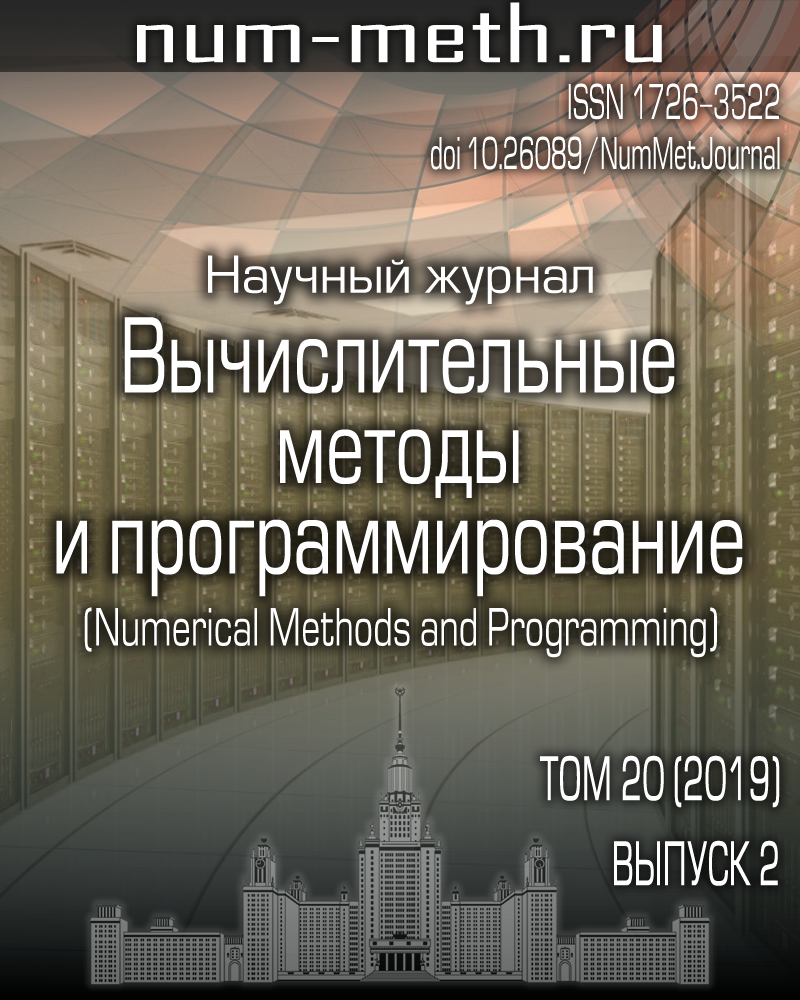DOI: https://doi.org/10.26089/NumMet.v20r216
О разностных схемах «кабаре» и «крест»
Ключевые слова:
задача переноса
схема «крест»
схема «кабаре»
линейно-взвешенная комбинация
повышение точности
Аннотация
Для решения задачи переноса в статье предложено использовать схему, построенную на основе линейной комбинации разностной схемы "кабаре" (англ. Upwind Leapfrog) и "крест" (англ. Standard Leapfrog) с весовыми коэффициентами, полученными в результате минимизации погрешности аппроксимации. Проведено сравнение расчетов для задачи переноса на основе предложенной схемы с результатами, полученными с использованием схемы, построенной на основе линейной комбинации схемы с центральными разностями и схемы "кабаре", и двухпараметрической разностной схемы третьего порядка точности.
Опубликован
2019-05-23
Выпуск
Раздел
Раздел 1. Вычислительные методы и приложения
Библиографические ссылки
- V. M. Goloviznin and A. A. Samarskii, “Finite Difference Approximation of Convective Transport Equation with Space Splitting Time Derivative,” Mat. Model. 10 (1), 86-100 (1998).
- A. I. Sukhinov, Yu. V. Belova, and A. E. Chistyakov, “Solution of the Matter Transport Problem at High Peclet Numbers,” Vychisl. Metody Programm. 18, 371-380 (2017).
- V. A. Gushchin, “Family of Quasi-Monotonic Finite-Difference Schemes of the Second-Order of Approximation,” Mat. Model. 28 (2), 6-18 (2016) [Math. Models Comput. Simul. 8 (5), 487-496 (2016)].
- O. M. Belotserkovskii, V. A. Gushchin, and V. N. Kon’shin, “The Splitting Method for Investigating Flows of a Stratified Liquid with a Free Surface,” Zh. Vychisl. Mat. Mat. Fiz. 27 (4), 594-609 (1987) [USSR Comput. Math. Math. Phys. 27 (2), 181-191 (1987)].
- A. A. Samarskii and P. N. Vabishchevich, Numerical Methods for Solving Convection-Diffusion Problems (Editorial, Moscow, 1999) [in Russian].
- M. E. Ladonkina, O. A. Neklyudova, and V. F. Tishkin, “Application of the RKDG Method for Gas Dynamics Problems,” Mat. Model. 26 (1), 17-32 (2014) [Math. Models Comput. Simul. 6 (4), 397-407 (2014)].
- V. M. Goloviznin, M. A. Zaitsev, S. A. Karabasov, and I. A. Korotkin, New CFD Algorithms for Multiprocessor Computer Systems (Mosk. Gos. Univ., Moscow, 2013) [in Russian].
- V. Yu. Glotov, V. M. Goloviznin, S. A. Karabasov, and A. P. Markesteijn, “New Two-Level Leapfrog Scheme for Modeling the Stochastic Landau-Lifshitz Equations,” Zh. Vychisl. Mat. Mat. Fiz. 54 (2), 298-317 (2014) [Comput. Math. Math. Phys. 54 (2), 315-334 (2014)].
- V. Yu. Glotov, A Mathematical Model of Free Turbulence Based on Maximum Principle , Candidate’s Dissertation in Mathematics and Physics (Keldysh Institute of Applied Mathematics, Moscow, 2014).
- A. A. Samarskii, “Regularization of Difference Schemes,” Zh. Vychisl. Mat. Mat. Fiz. 7 (1), 62-93 (1967) [USSR Comput. Math. Math. Phys. 7 (1), 79-120 (1967)].
- A. A. Samarskii, “Classes of Stable Schemes,” Zh. Vychisl. Mat. Mat. Fiz. 7 (5), 1096-1133 (1967) [USSR Comput. Math. Math. Phys. 7 (5), 171-223 (1967)].
- R. P. Fedorenko, “The Application of Difference Schemes of High Accuracy to the Numerical Solution of Hyperbolic Equations,” Zh. Vychisl. Mat. Mat. Fiz. 2 (6), 1122-1128 (1962) [USSR Comput. Math. Math. Phys. 2 (6), 1355-1365 (1963)].
- A. I. Sukhinov, A. E. Chistyakov, E. F. Timofeeva, and A. V. Shishenya, “Mathematical Model for Calculating Coastal Wave Processes,” Mat. Model. 24 (8), 32-44 (2012) [Math. Models Comput. Simul. 5 (2), 122-129 (2013)].
- A. I. Sukhinov, A. E. Chistyakov, and M. V. Iakobovskii, “Accuracy of the Numerical Solution of the Equations of Diffusion-Convection Using the Difference Schemes of Second and Fourth Order Approximation Error,” Vestn. Yuzhn. Ural. Gos. Univ. Ser. Vychisl. Mat. Inf. 5 (1), 47-62 (2016).


